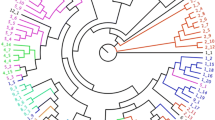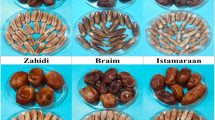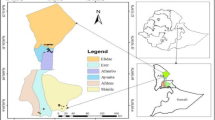Abstract
Genetic diversity in female date palms for a total of 89 tree samples, representing 18 cultivar groups, was investigated using 10 loci of microsatellite (SSR) primers. The microsatellites examined showed high polymorphism, a total of 126 for the 10 microsatellite loci, giving an average of 12.6. Low FST values were observed among different fruit classification groups of Sudanese date palms (soft, semi-soft and dry) suggesting that the observed high genetic variability is maintained locally within cultivars. Across all genetic parameters, in comparison among the cultivar groups, the Jaw group was consistently highly variable followed by Korsha, Gondela and Barakawi, respectively. Multivariate analysis of the 89 date palms showed some strong relationships with some mixed grouping, showing a tendency of relate fruit classification and related genotypes. Dry dates almost grouped together while the soft and semi-soft were mixed and somewhat related to genotypes. The effect of genotype was highly supported by the relationship of 14 cultivar groups, in which similar cultivars were associated regardless of the state to which they belong. Further detailed analyses of female date palm populations from different geographic locations represented by a minimum of five plants per cultivar is necessary to provide the basis for understanding of the date palm genomes, revealing the true extent of gene flow between farmer cultivars.



Similar content being viewed by others
Abbreviations
- AMOVA:
-
Analysis of molecular variance
- DNA:
-
Deoxyribonucleic acid
- FAO:
-
Food Agriculture Organisation
- OTU:
-
Operational taxonomic unit
- PCR:
-
Polymerase chain reaction
- RAPD:
-
Random Amplified Polymorphic DNA
- SSR:
-
Simple sequence repeats (microsatellites)
References
Al-Khalifah N, Askari E (2003) Molecular phylogeny of date palm (Phoenix dactylifera L.) cultivars from Saudi Arabia by DNA fingerprinting. Theor Appl Genet 107:1266–1270
Bennaceur M, Lanaud C, Chevalier MH, Bounaga N (1991) Genetic diversity of the date palm (Phoenix dactylifera L.) from Algeria revealed by enzyme markers. Plant Breed 107:56–69
Billotte N, Marseillac N, Brottier P, Noyer JL, Jacquemoud-Collet JP, Moreau C, Couvreur T, Chevallier MH, Pintaud JC, Risterucci AM (2004) Nuclear microsatellite markers for the date palm (Phoenix dactylifera L.): characterization and utility across the genus Phoenix and in other palm genera. Mol Ecol Notes 4:256–258
Brookfield JFY (1996) A simple new method for estimating null allele frequency from heterozygote deficiency. Mol Ecol 5:453–455
Cao BR, Chao CCT (2002) Identification of date cultivars in California using AFLP markers. HortScience 37:966–968
Chakraborty R, De Andrade M, Daiger SP, Budowle B (1992) Apparent heterozygote deficiencies observed in DNA typing data and their implications in forensic applications. Ann Hum Genet 56:45–57
Elsafy M (2012) Study on the on-farm diversity of local date palm (Phoenix dactylifera L.) genetic resources in Northern region of Sudan. MSc Thesis, Department of Plant Breeding and Biotechnology, Swedish University of Agricultural Sciences, Alnarp, Sweden
Elshibli S, Korpelainen H (2008) Microsatellite markers reveal high genetic diversity in date palm (Phoenix dactylifera L.) germplasm from Sudan. Genetica 134:251–260
Elshibli S, Korpelainen H (2009) Biodiversity of date palms (Phoenix dactylifera L.) in Sudan: chemical, morphological and DNA polymorphisms of selected cultivars. Plant Genet Resour C 7:194–203
Excoffier L, Laval G, Schneider S (2005) Arlequin version 3.0: an integrated software package for population genetics data analysis. Evol Bioinform. Online, 1:47–50. http://cmpg.unibe.ch/software/arlequin3. Accessed 13 Oct 2014
Ezebilo EE, Elsafi M, Garkava-Gustavsson L (2013) On-farm diversity of date palm (Phoenix dactylifera L.) in Sudan: a potential genetic resources conservation strategy. Sustainability 5:338–356
FAO (2014) Food and agriculture organization statistical databases (FAOSTAT). http://faostat.fao.org. Accessed 13 Oct 2014
Osman AMA (1984) The performance of date palms in the Sudan. Acta Hortic 143:231–238
Peakall R, Smouse PE (2006) GENALEX 6: genetic analysis in Excel. Population genetic software for teaching and research. Mol Ecol Notes 6:288–295
Rohlf FJ (2000) NTSYSpc numerical multivariate taxonomy and multivariate analysis system, version 2.1. Exeter Publishing, Ltd., Setauket, New York
Salem A, Trifi M, Salhi-Hannachi A et al (2001) Genetic variability analysis of Tunisian date-palm (Phoenix dactylifera L.) cultivars. J Genet Breed 55:269–278
Sedra MH, Lashermes P, Trouslot P, Combes MC (1998) Identification and genetic diversity analysis of date palm (Phoenix dactylifera L.) cultivars from Morocco using RAPD markers. Euphytica 103:75–82
Soliman SS, Ali BA, Ahmed MMM (2003) Genetic comparisons of Egyptian date palm cultivars (Phoenix dactylifera L.) by RAPD-PCR. Afr J Biotechnol 2:86–87
Van Oosterhout C, Hutchinson WF, Wills DPM, Shipley P (2004) Micro-checker: software for identifying and correcting genotyping errors in microsatellite data. Mol Ecol Notes 4:535–538
Yousif AA (1995) The date palm, vol 1. Khartoum University Press, Khartoum, Sudan, pp 27–280
Zehdi S, Trifi M, Billotte N, Marrakchi M, Christophe Pintaud J (2004) Genetic diversity of Tunisian date palms (Phoenix dactylifera L.) revealed by nuclear microsatellite polymprohism. Hereditas 141:278–287
Acknowledgments
All the appreciation to the Eastern Africa Plant Genetic Resources Network (EAPGRN) and Swedish International Development Agency (Sida) for the financial support of this study.
Author information
Authors and Affiliations
Corresponding author
Additional information
Claid Mujaju and Larisa Garkava-Gustavsson have contributed equally to this work.
Rights and permissions
About this article
Cite this article
Elsafy, M., Zborowska, A., Bryngelsson, T. et al. Elucidating the genetic diversity of farmer cultivars of female date palms (Phoenix dactylifera L.) from Sudan by microsatellite markers. Genet Resour Crop Evol 63, 975–986 (2016). https://doi.org/10.1007/s10722-015-0294-7
Received:
Accepted:
Published:
Issue Date:
DOI: https://doi.org/10.1007/s10722-015-0294-7




